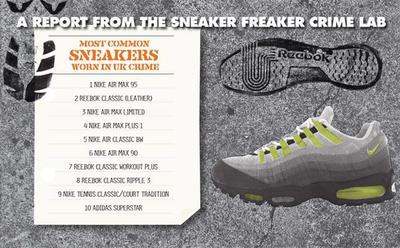Top Ten Sneakers In Crime!
As one of those aforementioned couch spuds (and a sneaker fan), I have noted with interest that the humble sneaker has left vital clues in many an episode of CSI. but HOW to separate fact from fiction? What role does the sneaker play in the forensic sciences? Aficionados may understandably muse over the merits of the speckled or gum sole, but the folks in the crime lab are more interested in the print shoes leave behind. As it happens, shoe prints are incredibly important clues often left at crime scenes. The number of shoe print patterns out there is huge. Shoe print indices and databases have been developed in various countries. Commercial company Foster and Freeman have a range of software tools to identify shoes, including SICAR and SoleMate. Forensic Science Services (FSS) is a UK Government owned company that released an online footwear coding and detection management system this year, entitled Footwear Intelligence Technology.
I contacted Laura Mackin at the FSS who informed me that they have records of more than 20,000 shoe prints of which approximately 90 per cent come from sneakers. I was intrigued as to how the database was compiled; were they getting shoes from the manufacturers? From shops? As it happens, all of the prints come from shoes given to the FSS by the 43 police forces around the UK, either from marks left at a crime scene or from sneakers confiscated from a suspect. Interestingly, the FSS don’t have any special agreements with manufacturers. This was a bit of a disappointment as I was hoping to learn that the most comprehensive sneaker collection in the UK was at the FSS.
The FSS also offer the fantastically named ‘Cinderella Service’, which helps identify personal information about suspects including the angle of their footfall and weight distribution. Facey wrote in the journal Pattern Recognition that ‘shape and extent of the the general wear apparent on a shoe sole contains information about the foot function and gait of the wearer.’ The use of US Army anthropometric databases has allowed models to predict height based on shoe size. English tabloid newspaper The Mirror reported this June, with perhaps a hint of schadenfreude at the shoe manufacturer’s expense, that sneakers are the most popular shoes used by criminals as evidenced by shoe prints, and listed the top ten shoes for English crims.
The list I received from the FSS was exactly the same; so there haven’t been any changes in the sneaker buying habits of the criminal world in the last few months. Whilst this list may provoke some tittering amongst tabloid readers or annoyance for the manufacturers PR companies, no mention is made of what the top ten sneakers sold are, and whether the two lists are significantly different; ie most bad boys may wear the top ten listed but perhaps so do the general population in England. It would be interesting to see how these lists vary between countries. The data is also for all crimes, rather than category of crime. The FSS doesn’t store this info, and I can imagine the manufacturers are at least grateful for that.
As with any forensic test, the shoe print is not a tool to be used without caution. A survey in the 1996 issue of Forensic Science International demonstrated ‘remarkable variations’ in conclusions of shoe print reports from different laboratories examining the same cases! Hopefully computer databases have reduced the error rate. Miss Mackin (FSS) informed me that ‘footwear is the second most common evidence type after DNA and is capable of definitively putting someone at a crime scene, particularly thanks to the unique wear marks that each pair will have’.
The Mirror’s article has a quote from someone at Nike who said (in response to their shoes being six of the top ten worn in British crimes): ‘We are Britain’s best-selling trainer manufacturer so we’re not surprised we feature. We’ve no further comment.’ Whilst this indeed is common sense as previously noted, perhaps they should consider another approach; embrace it. I see it now, The Prisoner Pack; all orange Air Max 90s, black and white striped Air Max 95s. And why not cash in on the whole ‘all over print’ phenomenon and do some hyperstrikes that have an all over arrow motif!
This has been Nikolai for Sneaker Freaker
reporting from the Crime Lab.
Huge thanks to Laura Mackin at the Forensic Science Service Labs and Prof James Fraser at The University of Strathclyde.
This article appeared in Issue 11 of Sneaker Freaker. Buy it

